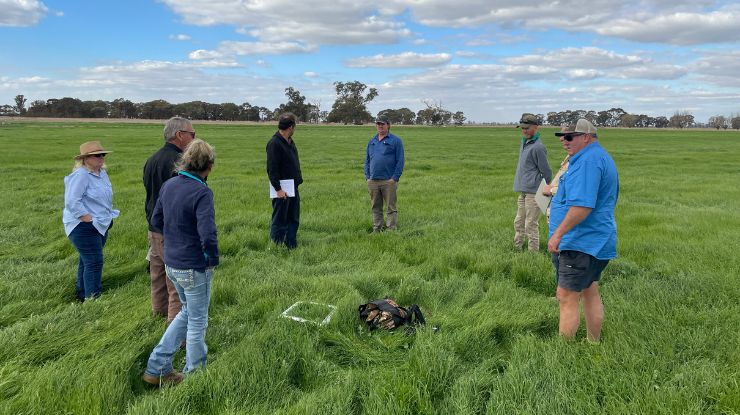 Members of the northern Victoria RLEM PDS group inspect pastures at the Strathallan site.
Members of the northern Victoria RLEM PDS group inspect pastures at the Strathallan site.
The tools helping producers protect their feedbase
Redlegged earth mites (RLEM) are increasingly resistant to insecticides and hard to detect early but producers in Victoria’s high rainfall zones are tackling this major pest to reduce its impact on feedbase productivity.
A new approach being tested through MLA’s ‘Less mites, more feed’ Producer Demonstration Site (PDS) is helping producers time spray applications more precisely, reduce unnecessary chemical use and improve pasture performance.
The PDS, which is led by Agridome Consultancy with support from research partner Cesar Australia, has demonstration sites in northern and western Victoria. The aim is to showcase best practice mite management strategies using three free online tools: TIMERITE®, the RLEM hatch timing tool and the RLEM severity risk calculator, developed by MLA, Grains Research and Development Corporation and Cesar Australia.
“These tools take the guesswork out of mite management,” project lead Matt Mahoney, Agridome, said.
“They let producers act with confidence by identifying the best spray dates and helping avoid unnecessary applications.”
The right time
The revised TIMERITE® tool, originally developed by CSIRO, has been updated to reflect changing climate conditions. The new version uses postcode rather than GPS data to generate a recommended spray window in spring, typically a month earlier than the old model, to reduce diapause eggs and autumn mite pressure.
Aston Arthur, an entomologist with Cesar Australia, conducts research on insecticide resistance. She said the new model can shift a producer’s spray date forward by up to four weeks.
“This is critical – spraying too early or too late compromises effectiveness, wastes product and effort, encourages resistance and harms beneficial insect populations.”
With resistance to pyrethroids and organophosphates already detected in parts of Victoria, timing is increasingly important.
On-farm trials showed the updated TIMERITE® dates significantly reduced mite numbers. At the Strathallan trial, RLEM numbers dropped by 90.3% using the revised timing, compared to 84.5% for the original timing. At the Mount Cole Creek trial, the updated timing achieved 100% control, while the original timing achieved only 36%.
Pasture management
Pasture growth and species composition were monitored using MLA’s pasture ruler and Pasture Paramedic tools. By autumn 2025, dry matter yield at Strathallan was 1,867kg/ha under the revised TIMERITE® spray date, compared to 1,237kg/ha in the non-sprayed control, a gain of more than 600kg/ha.
“We saw strong mite suppression when the spray date aligned with the tool’s recommendation,” Aston said.
“In some untreated areas, numbers climbed to more than 3,000 mites/m2, enough to cause real feed losses.”
Monitor hatching
Beyond TIMERITE®, the RLEM hatch timing tool helps producers monitor when mites are likely to emerge in autumn, while the RLEM severity risk calculator estimates seasonal pest pressure based on prior crop and management history.
“These are simple but powerful tools,” Matt said. “We’ve had strong producer engagement when they see the pasture response and realise the potential cost savings.”
The project’s final year includes three new field trial sites – Strathallan, Mount Dryden and Mount Cole Creek – comparing the revised TIMERITE® spray window with the original recommended timing.
Results to date show the updated TIMERITE® spray window consistently outperformed the original timing, delivering stronger mite control and improved pasture production, even under dry seasonal conditions.
“We’re not just reducing mite numbers, we’re giving producers practical tools to take control of their feedbase and protect it for the seasons ahead,” Aston said.



